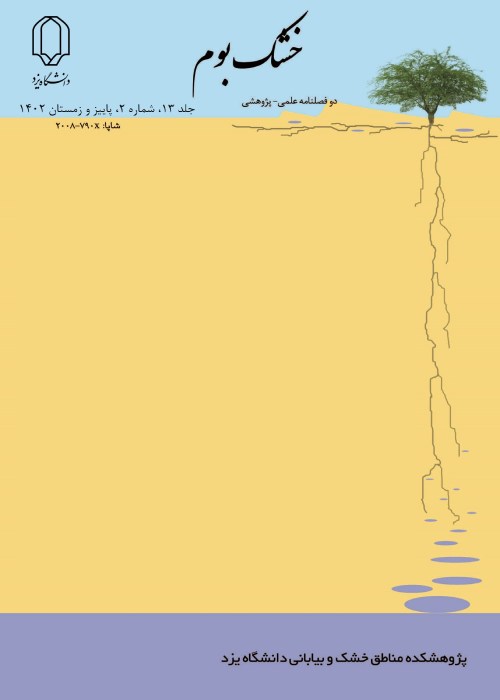Influence of Ziziphus spina-christi Residue on soil characteristics in Sahara-Sindy Ecosystem
Author(s):
Article Type:
Research/Original Article (دارای رتبه معتبر)
Abstract:
The health of the soil, as an ecosystem, influences the health of other ecosystems. The most essential factors associated to soil quality are its physical, chemical, and biological features, as well as its fertility. However, it is influenced by the type of plant that grows in it. Paying attention to the type of species and their effects on the qualitative characteristics of the soil as a management strategy can help maintain the quantity and long-term stability of restored areas in arid and desert areas in many land restoration projects, particularly in arid lands with limited resources. The purpose of this research is to look into the effect of the Ziziphus tree on physicochemical, microbiological, and stoichiometric ratios of soil in the arid region surrounding the Persian Gulf in the province of Khuzestan. For this purpose, 15 mixed soil samples were randomly selected from the surface soil at the foot of the Ziziphus tree, and 15 mixed samples were selected from the control areas in locations where the Ziziphus tree is not present. The characteristics of the soil samples were the same, including texture, acidity, organic carbon, organic matter, nitrogen, phosphorus, and potassium. The independent t-test was carried out to determine whether there was a significant difference between the two sample groups once the prerequisites for the two sample groups, such as the normality test and the homogeneity of variances, were completed. The results showed that in the Ziziphus samples, organic carbon was 41%, organic matter 47%, nitrogen 69%, C:K ratio 24%, and N:K ratio was 42% higher than in the control area with no Ziziphus. In terms of biological indicators, the Ziziphus samples rose 91% in basic respiration and 90% in microbial biomass carbon, indicating an increase in organic matter mineralization and soil health. In terms of the balance of ions in the exchange phase and solution. The results demonstrate that an increase of one unit in SAR raises the ESR level in the control samples by 1.6 times, compared to the side samples. This indicates that as the concentration of divalent ions in the solution phase increases, the exchange sites where the tree is absent, sodium ions will fill those spaces more quickly. According to the above findings, it can be concluded that using Ziziphus in land restoration projects improves microbiological conditions while also restoring the soil and enhancing its fertility and health.
Keywords:
Language:
Persian
Published:
Journal of Arid Biome, Volume:12 Issue: 1, 2023
Pages:
159 to 170
https://magiran.com/p2619607
دانلود و مطالعه متن این مقاله با یکی از روشهای زیر امکان پذیر است:
اشتراک شخصی
با عضویت و پرداخت آنلاین حق اشتراک یکساله به مبلغ 1,390,000ريال میتوانید 70 عنوان مطلب دانلود کنید!
اشتراک سازمانی
به کتابخانه دانشگاه یا محل کار خود پیشنهاد کنید تا اشتراک سازمانی این پایگاه را برای دسترسی نامحدود همه کاربران به متن مطالب تهیه نمایند!
توجه!
- حق عضویت دریافتی صرف حمایت از نشریات عضو و نگهداری، تکمیل و توسعه مگیران میشود.
- پرداخت حق اشتراک و دانلود مقالات اجازه بازنشر آن در سایر رسانههای چاپی و دیجیتال را به کاربر نمیدهد.
In order to view content subscription is required
Personal subscription
Subscribe magiran.com for 70 € euros via PayPal and download 70 articles during a year.
Organization subscription
Please contact us to subscribe your university or library for unlimited access!


